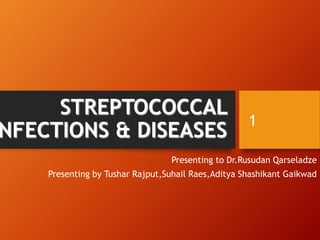
Streptococal Infection .ppt
- 1. STREPTOCOCCAL NFECTIONS & DISEASES Presenting to Dr.Rusudan Qarseladze Presenting by Tushar Rajput,Suhail Raes,Aditya Shashikant Gaikwad 1
- 2. INTRODUCTION • Streptococcus is Gram-positive bacteria classified as ß, α and γ according to complete, partial and no haemolysis on blood agar. • Streptococci are among the most common causes of bacterial infection in infancy and childhood. • Streptococci cause both suppurative and non- suppurative conditions. 2
- 3. GROUP A STREPTOCOCCUS (STREPTOCOCCUS PYOGENES) • This is the most important streptococcal species clinically causing both suppurative and non-suppurative diseases. Causes ß-haemolysis. • It has > 80 immunologically distinct types based on differences in the M protein in the outer layer of the cell wall. • The M antigen and lipoteichnoic acid are major virulence factors of the organism. Others are erythrogenic (pyrogenic) exotoxins, hyaluronidase, streptokinase, proteinase, streptolysin O and streptolysin S. 3
- 4. INCIDENCE • 10 – 20% of normal school children are colonized by this organism in their throat. • The incidence of Group A Streptococcal disease is lowest in infancy (they are protected by transplacentally acquired antibodies and the lack of pharyngeal receptors for the antigens of the organism). • Spread occurs by direct body contact and by air droplets. • Overcrowding and skin damage encourage streptococcal skin infections. 4
- 5. CLINICAL PRESENTATIONS • RESPIRATORY Presents similar to coryza in infants younger than 6 months Nasopharyngitis, cervical adenopathy, purulent nasal discharge, otitis media and sinusitis among children aged 6 months to 3 years. Tonsillitis, pharyngitis, meningism, peritonsillar and retropharyngeal abscesses occur in children aged more than 3 years. Pneumonia due to Strep pyogenes is usually very severe and rapidly progressive. 5
- 6. CLINICAL PRESENTATIONS • SKIN – Most of these commonly follow insect bites and scabetic infestation. Pyoderma (impetigo) Erysipelas usually of the face and extremities Cellulitis Necrotizing fasciitis Myositis Sometimes, abscesses may be formed. 6
- 7. CLINICAL PRESENTATIONS • SCARLET FEVER – No longer common in the antibiotic era. Used to be associated with significant mortality. It is due to the erythrogenic exotoxins. Incubates between 1 day and 1 week. Presents with tonsillopharyngitis, erythematous rash, fever and oedematous tongue. The rash is followed by extensive and severe desquamation. • BACTERAEMIA – follow localized lesions usually in debilitated patients. May thereafter lead to osteomyelitis, arthritis, pyelonephritis and meningitis. 7
- 8. CLINICAL PRESENTATIONS • VULVOVAGINITIS – usually among pre-pubertal girls. Presents with purulent vaginal discharge, pain and pruritus vulvae. • RHEUMATIC FEVER – This is a non-suppurative complication of Upper Respiratory Streptococcal infection affecting the heart, joints, skin and brain. It results in Rheumatic Heart Disease - the commonest acquired heart disease in most developing countries. • ACUTE GLOMERULONEPHRITIS – Another non- suppurative renal disease resulting from Strep. pyogenes infection of the skin (M49, 2, 55, 57) and throat (M12, 1,2,3). In the tropics, AGN commonly follows Streptococcal skin infections. 8
- 9. STREPTOCOCCUS PNEUMONIAE • This organism is encapsulated α- haemolytic diplococci. • Many healthy children carry the organism in their upper respiratory tract between 6 months and 4 years. The isolation peaks in the first 2 years of life and thereafter declines. • Males more affected than females. Blacks more affected than whites. • Majority of invasive diseases are due to serotypes 4, 6B, 9V, 14, 18C, 19F and 23F. 9
- 10. PATHOGENESIS • Pneumococcus does not cause surface infections. • Host defence mechanisms include epiglottic reflex which prevent aspiration of secretions containing the organisms, ciliary action which moves secretions towards the pharynx and secretions from the middle ear and sinuses which flow into the pharynx and not vice-versa. • When these are disturbed by viral infection and irritants like smoke, colonization by pneumococcus and disease occur. 10
- 11. PATHOGENESIS • The organisms multiply and spread via the lymphatics and blood to distant areas. It also spreads locally to contiguous sites. • Sickle cell disease, nephrotic syndrome, post-splenectomy state, HIV, congenital and acquired immune defects are predisposing factors. 11
- 12. CLINICAL FEATURES • These are related to the sites of infection Pneumonia Otitis media Sinusitis Orbital and peri-orbital cellulitis Pharyngitis Parotitis. • Local spread may produce empyema, pericarditis, mastoiditis and meningitis. 12
- 13. • GROUP B ß-HAEMOLYTIC STREPTOCOCCUS • This is a commensal of the vagina hence causes diseases in the newborns: septicaemia, pneumonia, otitis media, osteomyelitis and meningitis. • STREPTOCOCCUS VIRIDANS • A cause of bacterial endocarditis especially of non-native (prosthetic) valves. 13
- 14. DIAGNOSIS • Blood culture. • FBC – leucocytosis. • Throat swab for m/c/s. • Latex particle agglutination. • Anti-Streptolysin O (ASO) titire > 166 Todds Unit is highly suggestive of recent streptococcal invasive infection. 14
- 15. TREATMENT • The goal of treatment is to minimise the severity of symptoms and prevent suppurative and non- suppurative complications. • Penicillins are the drugs of choice. Oral Penicillin V 250 – 500mg bid for 5 days; intravenous Penicillin G 200, 000units/kg in 4 divided doses; long-acting benzathine penicillin 600, 000 – 1, 200, 000 units per dose. • Erythromycin (40mg/kg/day in 4 divided doses) and Cephalexin (100mg/kg/day in 2 divided doses) may also be used. 15
- 16. PREVENTION • Prophylactic Penicillins is indicated only for patients with specific predisposing factors like SCD, post-splenectomy, Nephrotic Syndrome, HIV and congenital immune defects. • Prophylactic Penicillin is also used in patients with Rheumatic Heart Disease. • No vaccine against Streptococcus pyogenes yet. • The polyvalent pneumococcal vaccine has poor immunogenicity in children younger than 2 years. • The conjugate polypeptide pneumococcal vaccine is newer and better because it has good immunogenicity in children as young as 2 months old. 16
- 18. THANK YOU 18